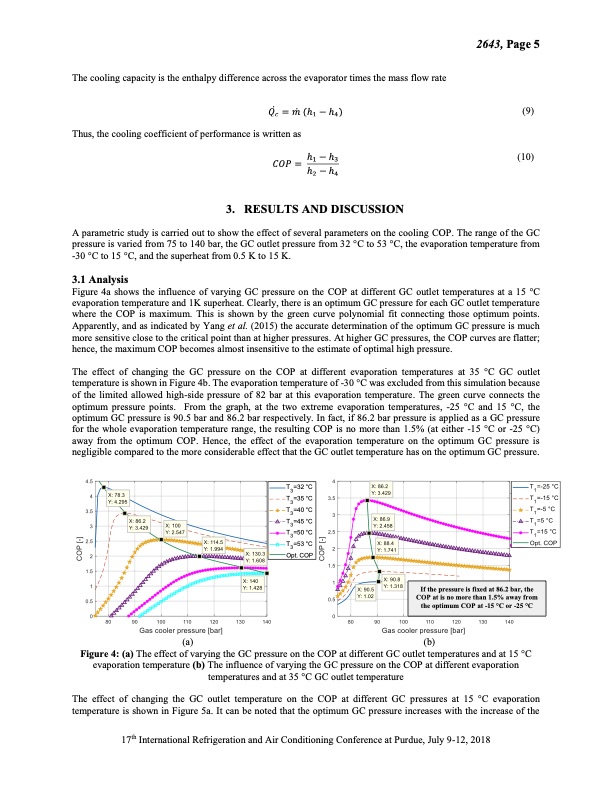
PDF Publication Title:
Text from PDF Page: 006
The cooling capacity is the enthalpy difference across the evaporator times the mass flow rate 𝑄̇ = 𝑚̇ (h − h ) (9) Thus, the cooling coefficient of performance is written as 𝐶𝑂𝑃 = h1 − h3 (10) h2 − h4 3. RESULTS AND DISCUSSION A parametric study is carried out to show the effect of several parameters on the cooling COP. The range of the GC pressure is varied from 75 to 140 bar, the GC outlet pressure from 32 °C to 53 °C, the evaporation temperature from -30 °C to 15 °C, and the superheat from 0.5 K to 15 K. 3.1 Analysis Figure 4a shows the influence of varying GC pressure on the COP at different GC outlet temperatures at a 15 °C evaporation temperature and 1K superheat. Clearly, there is an optimum GC pressure for each GC outlet temperature where the COP is maximum. This is shown by the green curve polynomial fit connecting those optimum points. Apparently, and as indicated by Yang et al. (2015) the accurate determination of the optimum GC pressure is much more sensitive close to the critical point than at higher pressures. At higher GC pressures, the COP curves are flatter; hence, the maximum COP becomes almost insensitive to the estimate of optimal high pressure. The effect of changing the GC pressure on the COP at different evaporation temperatures at 35 °C GC outlet temperature is shown in Figure 4b. The evaporation temperature of -30 °C was excluded from this simulation because of the limited allowed high-side pressure of 82 bar at this evaporation temperature. The green curve connects the optimum pressure points. From the graph, at the two extreme evaporation temperatures, -25 °C and 15 °C, the optimum GC pressure is 90.5 bar and 86.2 bar respectively. In fact, if 86.2 bar pressure is applied as a GC pressure for the whole evaporation temperature range, the resulting COP is no more than 1.5% (at either -15 °C or -25 °C) away from the optimum COP. Hence, the effect of the evaporation temperature on the optimum GC pressure is negligible compared to the more considerable effect that the GC outlet temperature has on the optimum GC pressure. 𝑐14 2643, Page 5 If the pressure is fixed at 86.2 bar, the COP at is no more than 1.5% away from the optimum COP at -15 °C or -25 °C 4.5 3.5 2.5 1.5 0.5 4 3 2 1 T3=32 °C T3=35 °C T3=40 °C T3=45 °C T3=50 °C T3=53 °C Opt. COP 0 80 90 100 110 120 130 140 Gas cooler pressure [bar] (a) Figure 4: (a) The effect of varying the GC pressure on the COP at different GC outlet temperatures and at 15 °C evaporation temperature (b) The influence of varying the GC pressure on the COP at different evaporation temperatures and at 35 °C GC outlet temperature The effect of changing the GC outlet temperature on the COP at different GC pressures at 15 °C evaporation temperature is shown in Figure 5a. It can be noted that the optimum GC pressure increases with the increase of the 17th International Refrigeration and Air Conditioning Conference at Purdue, July 9-12, 2018 (b) COP [-]PDF Image | Transcritical CO2 Heat Pump Cycle

PDF Search Title:
Transcritical CO2 Heat Pump CycleOriginal File Name Searched:
220147355.pdfDIY PDF Search: Google It | Yahoo | Bing
CO2 Organic Rankine Cycle Experimenter Platform The supercritical CO2 phase change system is both a heat pump and organic rankine cycle which can be used for those purposes and as a supercritical extractor for advanced subcritical and supercritical extraction technology. Uses include producing nanoparticles, precious metal CO2 extraction, lithium battery recycling, and other applications... More Info
Heat Pumps CO2 ORC Heat Pump System Platform More Info
| CONTACT TEL: 608-238-6001 Email: greg@infinityturbine.com | RSS | AMP |